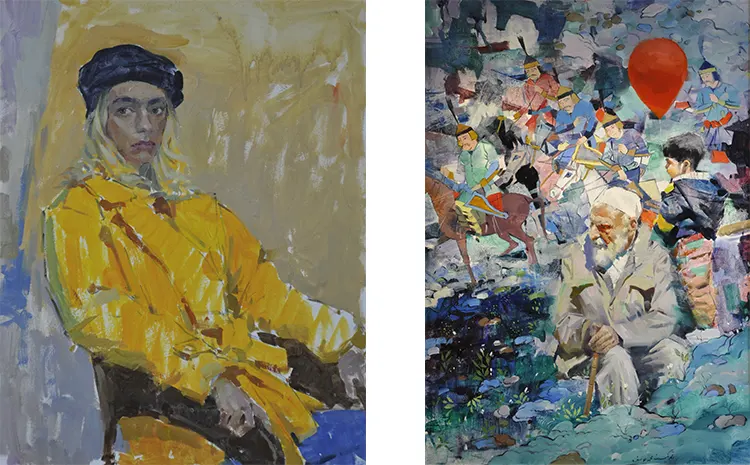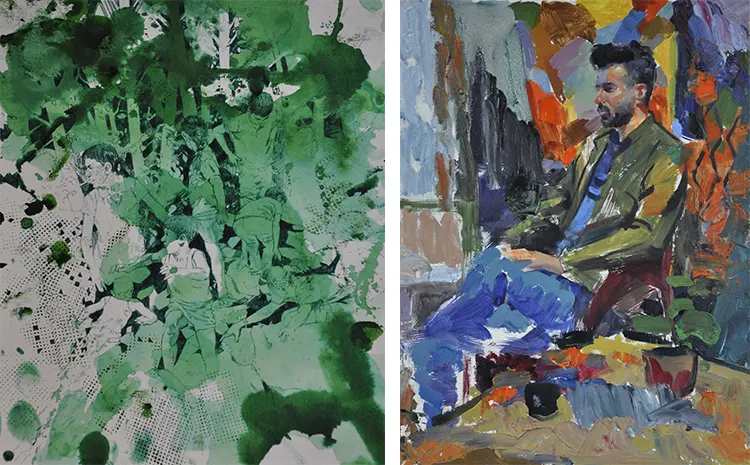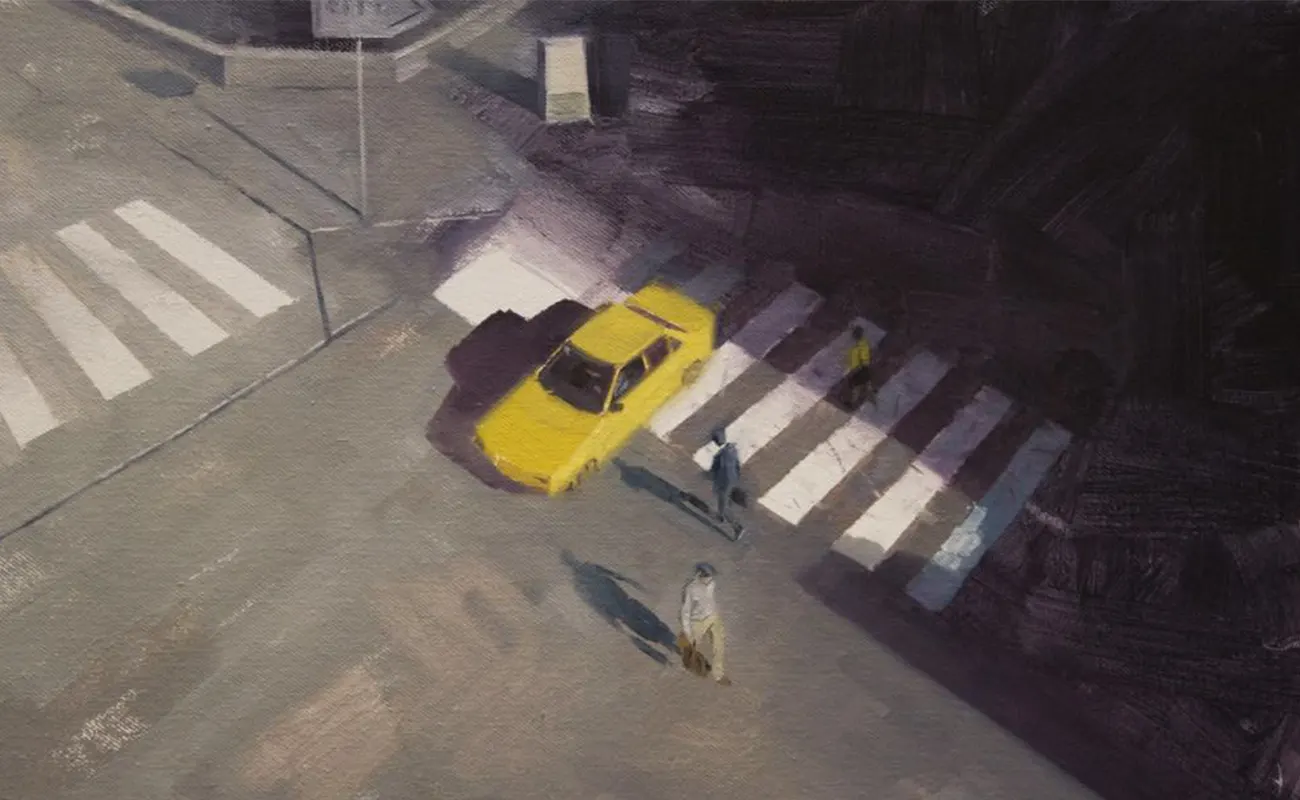“My dream project is to paint very large canvases with figurative and decorative elements combined.”
The Charcoal Delight
Ehsan Maleki is an artist from the ancient city of Esfahan in central Iran, who now resides and creates in the bustling metropolis of Tehran. His education in painting and drawing was cultivated at the distinguished Esfahan Fine Art school, a reputable institution within Iran known for its excellence in fostering artistic talent.
Esfahan, Maleki’s hometown, is a city steeped in a rich tapestry of Safavi architecture. It is renowned for its opulent monuments, each one adorned with intricate murals and ornate calligraphy that narrate a captivating story. The vibrant pulse of this artistic sanctuary naturally influenced Maleki, whose interest in the arts was piqued from a tender age.
Maleki hails from a family not conventionally associated with the arts. Despite this, he displayed an inherent proclivity towards crafting and molding objects from his nascent years. Whether it was through carving intricate patterns into wood or deftly shaping clay, he reveled in the act of creation. The essence of Maleki’s process lay in initially envisioning the final piece, which then guided him towards selecting the most fitting material to realize his conception.
The art of drawing, for Maleki, acted as an effective conduit between his envisioned idea and its materialization on paper. This method offered a streamlined approach to transpose his unique visions into tangible art, thus becoming an instrumental technique in the progression of his artistic journey.

Oil Painting Brilliance: Ehsan Maleki’s Masterful Use of Colors and Textures
Ehsan Maleki often identifies himself as a creative shapeshifter. His stylistic preferences veer away from hyperrealism and pure abstraction, steering instead towards a broad spectrum of artistic experimentation. In this rich tapestry of artistic exploration, Maleki manifests a compelling predilection for painting human figures in relational contexts, such as the riveting “Siblings” series.
In his artwork, Maleki masterfully captures individuals experiencing profound, often unshared emotions. His paintings reveal silent echoes of life, transforming moments into timeless narratives of human connection. The multifigure compositions he creates serve as poignant snapshots, encapsulating the ephemeral nature of social and familial relationships, the inevitable divergence of paths symbolizing the impermanent nature of these bonds.
Maleki’s sketchbook, a personal artistic sanctuary, is instrumental in his creative process. Unrestricted by logistics, this versatile canvas allows him the freedom to express his creative vision unhindered. In this intimate space, Maleki’s talent flourishes unrestrained, resulting in an array of masterpieces that reflect his unique artistic identity.

Eastern and Western Inspirations
Ehsan Maleki demonstrates a distinct predilection for the use of charcoal in his drawings, valuing its fluid quality that echoes the dynamism of painting. His other favored medium for sketching is ink, prized for its almost irreversible nature that delivers sharp contrasts and robust lines.
In the realm of painting, Maleki predominantly employs oil, with watercolor serving as a secondary medium. His artistic style draws inspiration from a diverse range of art historical sources.
In the rich tapestry of Western art, Maleki has studied and gleaned insights from the oeuvre of myriad eminent artists since the time of Giotto. Among the notable ones, he recurrently revisits works by Caravaggio, Tiepolo, Velázquez, Hals, Sorolla, Bonnard, and Fechin. These masters serve as an inexhaustible source of inspiration, providing him valuable insights into the resolution of painting challenges.
Simultaneously, Maleki expresses a profound admiration for the Eastern tradition, particularly finding inspiration in the intricate work of Japanese artists from the Yukio-e era. Additionally, he reveres the Persian miniature paintings originating from the Tabriz and Esfahan schools. Through this diverse artistic influence, Maleki shapes his unique artistic identity, creating an intriguing fusion of Eastern and Western aesthetics.

Drawing from the Masters: Ehsan Maleki’s Insights from Art History’s Finest
Ehsan Maleki has always found a profound source of inspiration in the iconic painting “Supper at Emmaus” by Caravaggio. This renowned piece, renowned for its exceptional technical execution and conceptual depth, signifies a milestone in the realm of Western art. Maleki appreciates its impeccable composition that unifies human figures and still-life elements, employing a dramatic interplay of light and shadow to encapsulate a moment of revelation. Interestingly, Maleki reflects on a childhood misinterpretation, initially perceiving the individuals depicted at the table as hunters proudly displaying their catch.
Maleki’s ambitious artistic aspirations encompass the creation of expansive canvases. His vision is to generate works imbued with a fusion of figurative and decorative elements. Parallel to this, he has begun to realize another grand project. He has embarked on the mission of illustrating Ferdousi’s “Shahname,” commonly known as the “Epic of Kings”. Both of these undertakings reflect Maleki’s diverse artistic objectives and his passion for the convergence of traditional and contemporary elements within his craft.






